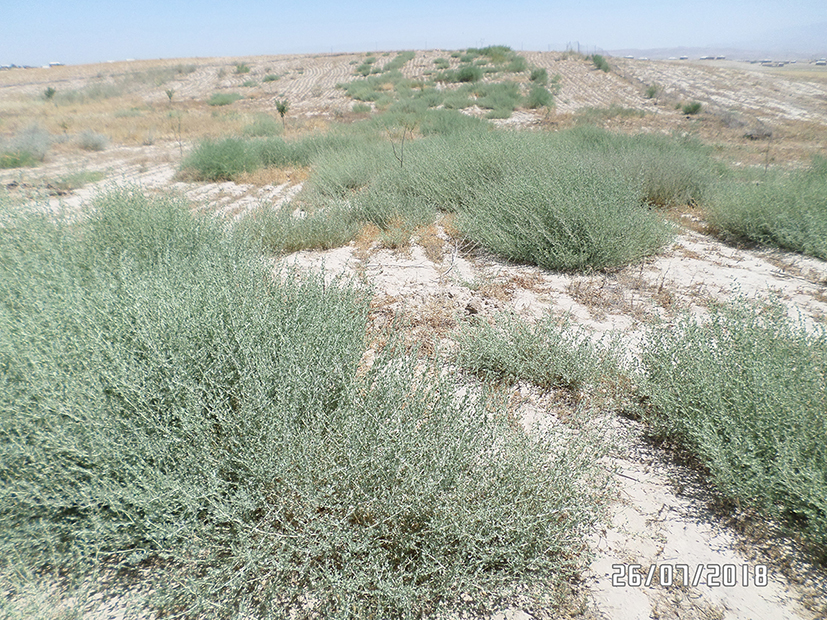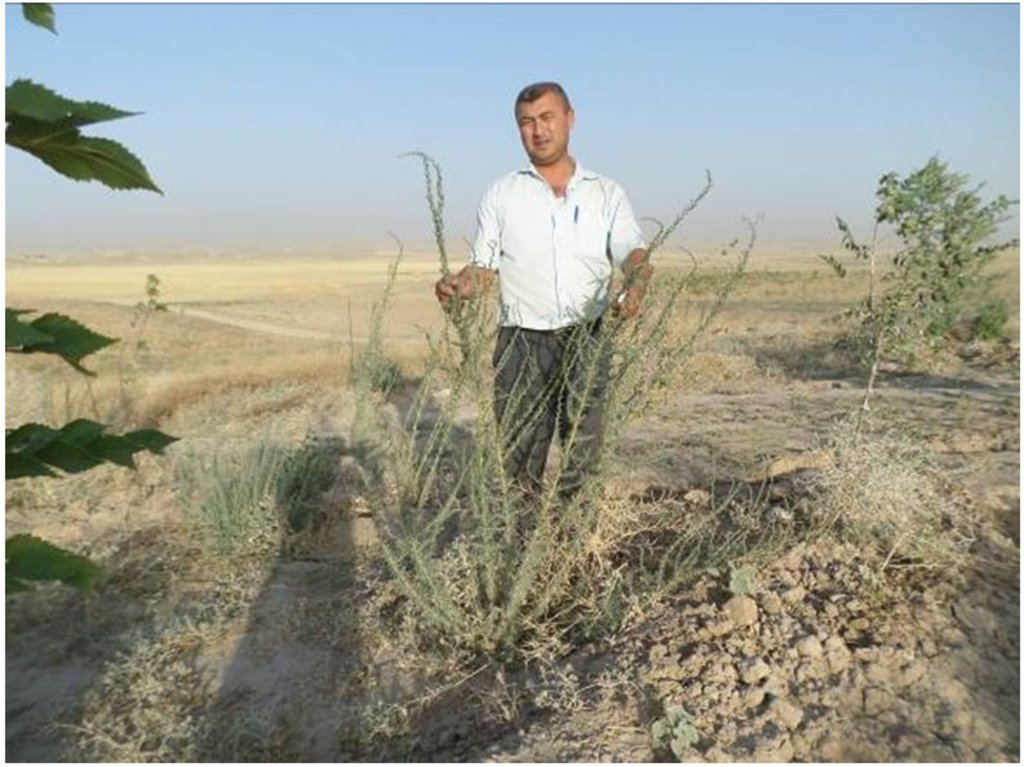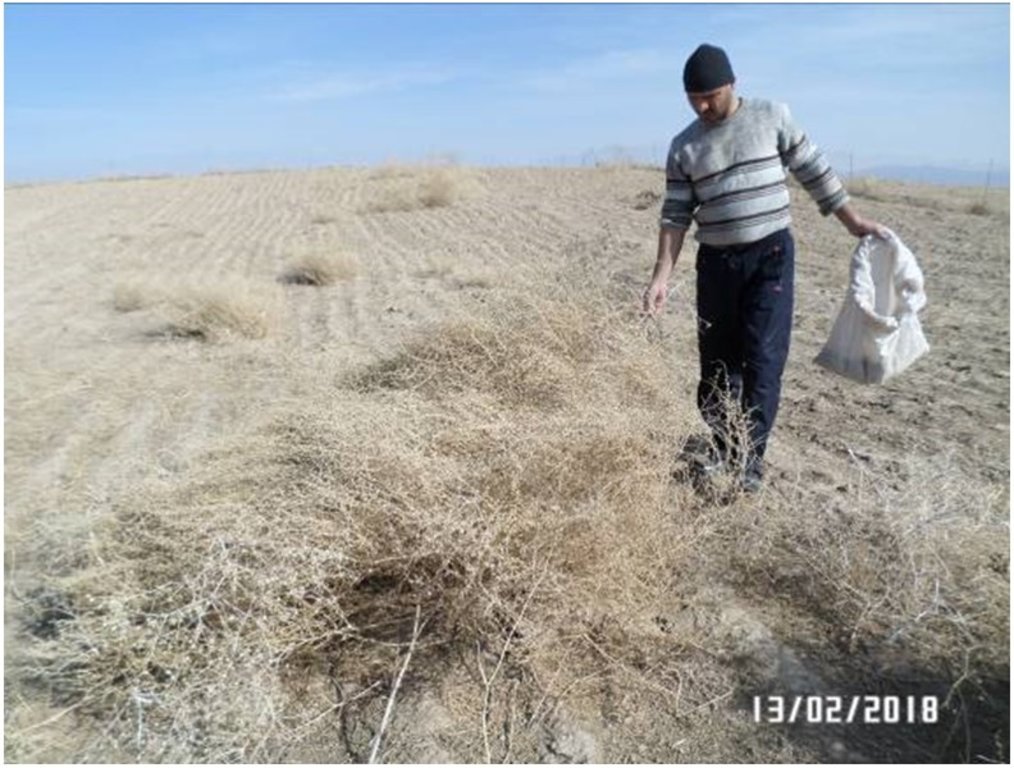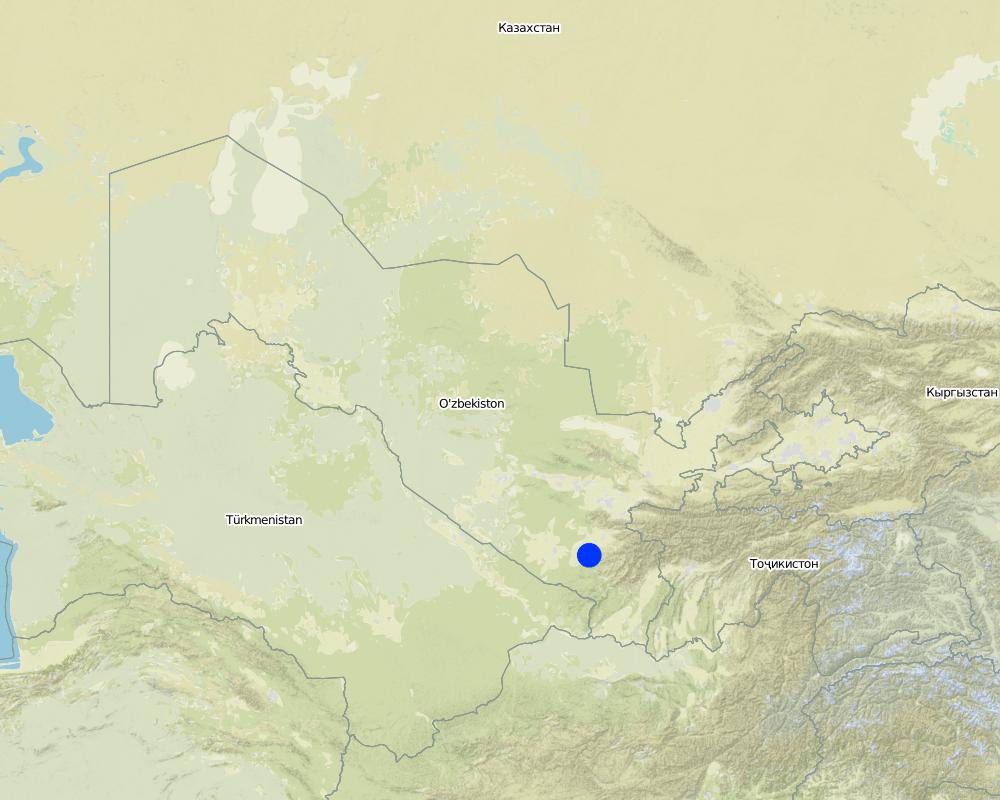Выращивание пустынных засухоустойчивых культур на богаре для повышения кормопроизводства и предотвращения эрозии [Uzbekistan]
- Creation:
- Update:
- Compiler: Rustam Ibragimov
- Editor: –
- Reviewers: Olga Andreeva, Elizaveta Soloveyva, Alexandra Gavilano
Выращивание пустынных засухоустойчивых культур на богаре для повышения кормопроизводства и предотвращения эрозии
technologies_3650 - Uzbekistan
- Full summary as PDF
- Full summary as PDF for print
- Full summary in the browser
- Full summary (unformatted)
- Выращивание пустынных засухоустойчивых культур на богаре для повышения кормопроизводства и предотвращения эрозии: Sept. 11, 2018 (inactive)
- Выращивание пустынных засухоустойчивых культур на богаре для повышения кормопроизводства и предотвращения эрозии: Aug. 22, 2019 (inactive)
- Drought-resistant crops to enhance forage production and prevent erosion in desert areas: Jan. 21, 2020 (public)
View sections
Expand all Collapse all1. General information
1.2 Contact details of resource persons and institutions involved in the assessment and documentation of the Technology
Key resource person(s)
SLM specialist:
Мукимов Толибжон, Худайкулович
Научно-исследовательский институт каракулеводства и экологии пустынь
Uzbekistan
1.3 Conditions regarding the use of data documented through WOCAT
The compiler and key resource person(s) accept the conditions regarding the use of data documented through WOCAT:
Yes
1.4 Declaration on sustainability of the described Technology
Is the Technology described here problematic with regard to land degradation, so that it cannot be declared a sustainable land management technology?
No
2. Description of the SLM Technology
2.1 Short description of the Technology
Definition of the Technology:
Выращивание пустынных кормовых растений в богарных условиях обеспечивает адаптацию к засухе, создает кормовые запасы для животноводства и предотвращает развитие водной эрозии
2.2 Detailed description of the Technology
Description:
Для населения, проживающего в богарной зоне, животноводство является основным источником жизнеобеспечения и благополучия, доля которого в семейном бюджете составляет 80-95%. Поэтому, создание прочной кормовой базы, способной обеспечить развитие животноводства и решить проблему сохранения биоразнообразия при удовлетворении жизненных потребностей населения, является основной задачей. Урожайность богарных пастбищ в Узбекистане находится в большой зависимости от погодных условий и резко меняется по годам и сезонам (от 1,5-2,0 до 5 ц/га). Не рациональное использование пастбищ, слабое применение мероприятий по восстановлению деградированных участков, а также ряд других факторов обусловили значительное увеличение антропогенной нагрузки на пастбища, что способствовало их деградации. Выращивание пустынных кормовых растений на богаре, таких как изен (Kochia prostrata), чогон (Halothamus subaphylla), терескен (Ceratoides Ewersmanniana), атриплекс (Atriplex undulata) и др., максимально приспособленных к почвенной и воздушной засухе, позволит создать дополнительные кормовые запасы, снизить нагрузку на пастбища и обеспечить сбалансированное питание животных. В первый год вегетации урожайность пустынных растений составляет 1,5- 1,6 ц/га сухой массы, во второй год - 2,2-3,5 ц/га сухой кормовой массы и около 0,4 ц/га семян; в третий год 8-12 ц/га сухой массы и 1,0-1,2 ц/га семян. При правильном использовании семенных посевов и пастбищных агрофитоценозов данные растительные сообщества способны само восстанавливаться в течение 20-35 лет.
Мероприятия и вклады на введение/содержание:Для расширения технологии на богаре необходимо создавать питомники первичного семеноводства, чтобы обеспечить семенами землепользователей. Технология выращивания пустынных растений включает вспашку на глубину 20-22 см, боронование, малование и сев с заделкой семян боронованием. Посев проводят в декабре – феврале нормой высева 12-15 кг/га, глубина заделки семян - 0,5-2 см. Уборку семян проводят в октябре-ноябре. Семена очищают, сушат и хранят при влажности не более 12%. При правильном способе хранения семена не теряют всхожесть в течение 6-9 месяцев после уборки. Для создания питомников первичного семеноводства на богаре требует порядка 700 000-850 000 сум/га (в пределах 100 долл.США/га).
Природная/социальная среда: Особенностью богарных условий на территории применения технологии является низкая обеспеченность осадками и подверженность почв водной и ветровой эрозии. Для повышения продуктивности богары в настоящее время расширяются площади под засухоустойчивыми видами культур, такими, как софлор. Поиск альтернативных решений и поддержка местного сообщества, основное занятие которого богарное земледелие и скотоводство, имеет первостепенное значение для повышения уровня жизни и благосостояния. Создание посевов из многолетних пустынных кормовых растений для кормопроизводства обеспечивает поддержку скотоводов и земледельцев. Технология предоставляет экологические выгоды, содействует смягчению воздействия изменения климата путем секвестрации СО2 в биомассе растений и почве (до 480 кг/га) и способствует общему оздоровлению окружающей среды.
2.3 Photos of the Technology
2.5 Country/ region/ locations where the Technology has been applied and which are covered by this assessment
Country:
Uzbekistan
Region/ State/ Province:
Камашинский район, Кашкадарьинская область
Further specification of location:
г. Камаши
Specify the spread of the Technology:
- applied at specific points/ concentrated on a small area
Comments:
эксперимент и адаптация технологии выполняется на деградированных землях богарной зоны площадью 1 гектар
Map
×2.6 Date of implementation
Indicate year of implementation:
2015
If precise year is not known, indicate approximate date:
- less than 10 years ago (recently)
2.7 Introduction of the Technology
Specify how the Technology was introduced:
- through projects/ external interventions
Comments (type of project, etc.):
Эксперименты и исследования проведены учеными Узбекистана 30 лет назад. Внедрена технология в рамках Проекта ГЭФ/ФАО/ВОКАТ «Поддержка решений для продвижения и распространения устойчивого управления земельными ресурсами (DS-SLM) (2016-2018)
3. Classification of the SLM Technology
3.1 Main purpose(s) of the Technology
- improve production
- reduce, prevent, restore land degradation
- preserve/ improve biodiversity
- adapt to climate change/ extremes and its impacts
- mitigate climate change and its impacts
- create beneficial economic impact
- Создание базы кормопроизводства и гарантированных кормовых запасов для домашнего скота с целью повышения продуктивности скота и снижения нагрузки на пастбища
3.2 Current land use type(s) where the Technology is applied

Grazing land
Extensive grazing:
- Semi-nomadic pastoralism
- Полукочевое/ отгонное животноводство, Поголовье скота на единицу площади (если применимо): 2 головы на 1 гектар
- Мелкий и крупный рогатый скот - шерсть, мясо, молоко
Comments:
Сельхозполя (пахотные угодья) и плантации: деградированные земли богарной зоны, на которых прежде возделывались зерновые
3.4 Water supply
Water supply for the land on which the Technology is applied:
- rainfed
Comments:
Число урожаев за год:
2
Поясните:
2 укоса кормовых культур (весной и осенью)
3.5 SLM group to which the Technology belongs
- integrated crop-livestock management
- improved ground/ vegetation cover
3.6 SLM measures comprising the Technology

agronomic measures
- A1: Vegetation/ soil cover

vegetative measures
- V2: Grasses and perennial herbaceous plants

management measures
- M1: Change of land use type
3.7 Main types of land degradation addressed by the Technology

soil erosion by water
- Wt: loss of topsoil/ surface erosion

soil erosion by wind
- Et: loss of topsoil

biological degradation
- Bc: reduction of vegetation cover
Comments:
Природные причины деградации: необеспеченность осадками богарной зоны земледелия, ветровая и водная эрозия на склонах;
антропогенная: отсутствие полезащитных лесополос, несоответствующая агротехника обработки почвы, не применяются различные приемы и способы, снижающие испарение с поверхности почвы и повышающие влагонакопление, недостаточное разнообразие засухоустойчивых сортов и видов культурных растений и др.
3.8 Prevention, reduction, or restoration of land degradation
Specify the goal of the Technology with regard to land degradation:
- reduce land degradation
- restore/ rehabilitate severely degraded land
Comments:
Повышение продуктивности земель, за счет интенсивных культур и включения в травостой бобовых трав, повышение биоразнообразия
4. Technical specifications, implementation activities, inputs, and costs
4.1 Technical drawing of the Technology
Technical specifications (related to technical drawing):
Посев пустынных засухоустойчивых растений на участке выполняется полосами шириной 5 м с чередованием различных видов. сев проводят нормой 12-15 кг/га, заделка семян осуществляется боронованием или малованием на глубину 0,5-2 см. Такая схема сева обеспечивает биологическое разнообразие и оптимальную плотность растительного покрова.
Author:
T. Mukimov
4.2 General information regarding the calculation of inputs and costs
Specify how costs and inputs were calculated:
- per Technology area
Indicate size and area unit:
1 гектар
Specify currency used for cost calculations:
- USD
If relevant, indicate exchange rate from USD to local currency (e.g. 1 USD = 79.9 Brazilian Real): 1 USD =:
4150.0
Indicate average wage cost of hired labour per day:
4, 75 долл. США
4.3 Establishment activities
| Activity | Timing (season) | |
|---|---|---|
| 1. | Планировка, вспашка, малование, боронование | Зима- весна |
| 2. | Посев | Декабрь-февраль |
| 3. | Уход за посевами | Апрель-май |
| 4. | Укосы | Май-октябрь |
| 5. | Охрана участка | в течении вегетации |
Comments:
Мероприятия по запуску технологии включают обычную агротехнику сева культур с соблюдением особенностей (глубина заделки, нормы высева семян и др.)
4.4 Costs and inputs needed for establishment
| Specify input | Unit | Quantity | Costs per Unit | Total costs per input | % of costs borne by land users | |
|---|---|---|---|---|---|---|
| Labour | Труд рабочего по посадке | долл. США/га | 1.0 | 60.0 | 60.0 | |
| Equipment | Использование механизации при севе | долл. США/га | 1.0 | 21.0 | 21.0 | |
| Plant material | Семена пустынных растений | долл. США/га | 1.0 | 40.0 | 40.0 | |
| Construction material | Огораживание участка | долл. США/га | 1.0 | 200.0 | 200.0 | |
| Total costs for establishment of the Technology | 321.0 | |||||
| Total costs for establishment of the Technology in USD | 0.08 | |||||
If land user bore less than 100% of costs, indicate who covered the remaining costs:
проектом
4.5 Maintenance/ recurrent activities
| Activity | Timing/ frequency | |
|---|---|---|
| 1. | Уход за посевами | вегетация |
| 2. | Укосы | 2- раза в период цветения и плодоношения |
| 3. | Охрана участка | в течение вегетации |
4.6 Costs and inputs needed for maintenance/ recurrent activities (per year)
| Specify input | Unit | Quantity | Costs per Unit | Total costs per input | % of costs borne by land users | |
|---|---|---|---|---|---|---|
| Labour | Труд рабочего по уходу за посевами | долл. США/га | 1.0 | 60.0 | 60.0 | 100.0 |
| Plant material | Укосы | долл. США/га | 1.0 | 40.0 | 40.0 | 100.0 |
| Total costs for maintenance of the Technology | 100.0 | |||||
| Total costs for maintenance of the Technology in USD | 0.02 | |||||
If you are unable to break down the costs in the table above, give an estimation of the total costs of maintaining the Technology:
100.0
4.7 Most important factors affecting the costs
Describe the most determinate factors affecting the costs:
Наибольшие затраты в первый год реализации технологии относятся к закупке семян и огораживанию участка от потравли скотом
5. Natural and human environment
5.1 Climate
Annual rainfall
- < 250 mm
- 251-500 mm
- 501-750 mm
- 751-1,000 mm
- 1,001-1,500 mm
- 1,501-2,000 mm
- 2,001-3,000 mm
- 3,001-4,000 mm
- > 4,000 mm
Specify average annual rainfall (if known), in mm:
120.00
Specifications/ comments on rainfall:
сумма осадков, 90% осадков приходится на октябрь-май
Indicate the name of the reference meteorological station considered:
Камаши
Agro-climatic zone
- semi-arid
Продолжительность вегетационного периода естественной растительности составляет 90-100 дней
5.2 Topography
Slopes on average:
- flat (0-2%)
- gentle (3-5%)
- moderate (6-10%)
- rolling (11-15%)
- hilly (16-30%)
- steep (31-60%)
- very steep (>60%)
Landforms:
- plateau/plains
- ridges
- mountain slopes
- hill slopes
- footslopes
- valley floors
Altitudinal zone:
- 0-100 m a.s.l.
- 101-500 m a.s.l.
- 501-1,000 m a.s.l.
- 1,001-1,500 m a.s.l.
- 1,501-2,000 m a.s.l.
- 2,001-2,500 m a.s.l.
- 2,501-3,000 m a.s.l.
- 3,001-4,000 m a.s.l.
- > 4,000 m a.s.l.
Indicate if the Technology is specifically applied in:
- not relevant
5.3 Soils
Soil depth on average:
- very shallow (0-20 cm)
- shallow (21-50 cm)
- moderately deep (51-80 cm)
- deep (81-120 cm)
- very deep (> 120 cm)
Soil texture (topsoil):
- medium (loamy, silty)
Soil texture (> 20 cm below surface):
- fine/ heavy (clay)
Topsoil organic matter:
- low (<1%)
5.4 Water availability and quality
Ground water table:
5-50 m
Availability of surface water:
poor/ none
Water quality (untreated):
good drinking water
Is water salinity a problem?
No
Is flooding of the area occurring?
No
Comments and further specifications on water quality and quantity:
Кормовые культуры выращиваются без орошения
5.5 Biodiversity
Species diversity:
- low
Habitat diversity:
- low
Comments and further specifications on biodiversity:
Растительность богары представлена в основном культурными растениями (оз.пшеница, софлор). После уборки поверхность земли пересыхает и остается без растительности вследствие отсутствия осадков
5.6 Characteristics of land users applying the Technology
Sedentary or nomadic:
- Sedentary
Market orientation of production system:
- mixed (subsistence/ commercial)
Off-farm income:
- > 50% of all income
Relative level of wealth:
- average
Individuals or groups:
- cooperative
Level of mechanization:
- mechanized/ motorized
Gender:
- men
Age of land users:
- middle-aged
5.7 Average area of land used by land users applying the Technology
- < 0.5 ha
- 0.5-1 ha
- 1-2 ha
- 2-5 ha
- 5-15 ha
- 15-50 ha
- 50-100 ha
- 100-500 ha
- 500-1,000 ha
- 1,000-10,000 ha
- > 10,000 ha
Is this considered small-, medium- or large-scale (referring to local context)?
- medium-scale
5.8 Land ownership, land use rights, and water use rights
Land ownership:
- state
- individual, titled
Land use rights:
- leased
Water use rights:
- individual
- Вода для питья в основном привозная из-за отсутствия поверхностных источников и глубокого залегания подземных вод. Оросительная вода отсутствует
5.9 Access to services and infrastructure
health:
- poor
- moderate
- good
education:
- poor
- moderate
- good
technical assistance:
- poor
- moderate
- good
employment (e.g. off-farm):
- poor
- moderate
- good
markets:
- poor
- moderate
- good
energy:
- poor
- moderate
- good
roads and transport:
- poor
- moderate
- good
drinking water and sanitation:
- poor
- moderate
- good
financial services:
- poor
- moderate
- good
6. Impacts and concluding statements
6.1 On-site impacts the Technology has shown
Socio-economic impacts
Production
fodder production
fodder quality
Income and costs
expenses on agricultural inputs
farm income
Comments/ specify:
2,5 млн. сум чистого дохода
workload
Ecological impacts
Soil
soil accumulation
Biodiversity: vegetation, animals
Vegetation cover
biomass/ above ground C
plant diversity
Climate and disaster risk reduction
drought impacts
micro-climate
6.2 Off-site impacts the Technology has shown
impact of greenhouse gases
Specify assessment of off-site impacts (measurements):
Технология не оказывает отрицательного влияния на окружающую среду, некоторые виды бобовых улучшают почву, увеличивается биоразнообразие, за счет полночленности созданного ярусного фитоценоза (кустарники, полукустарники, травы) и развития под покровом травянистой растительности.
6.3 Exposure and sensitivity of the Technology to gradual climate change and climate-related extremes/ disasters (as perceived by land users)
Gradual climate change
Gradual climate change
| Season | increase or decrease | How does the Technology cope with it? | |
|---|---|---|---|
| annual temperature | increase | very well | |
| seasonal temperature | summer | increase | well |
| annual rainfall | decrease | well | |
| seasonal rainfall | spring | decrease | well |
| seasonal rainfall | summer | decrease | well |
Climate-related extremes (disasters)
Climatological disasters
| How does the Technology cope with it? | |
|---|---|
| heatwave | well |
| drought | well |
Other climate-related consequences
Other climate-related consequences
| How does the Technology cope with it? | |
|---|---|
| extended growing period | very well |
6.4 Cost-benefit analysis
How do the benefits compare with the establishment costs (from land users’ perspective)?
Short-term returns:
slightly positive
Long-term returns:
positive
How do the benefits compare with the maintenance/ recurrent costs (from land users' perspective)?
Short-term returns:
slightly positive
Long-term returns:
positive
Comments:
Краткосрочные положительные выгоды: Повышение урожайности и обеспечение полноценным гарантированным кормом скота в осенне-зимний период. Долгосрочные положительные выгоды: сохранение и повышение биоразнообразия , снижение нагрузки на пастбища
6.5 Adoption of the Technology
- 11-50%
Of all those who have adopted the Technology, how many did so spontaneously, i.e. without receiving any material incentives/ payments?
- 11-50%
6.6 Adaptation
Has the Technology been modified recently to adapt to changing conditions?
No
6.7 Strengths/ advantages/ opportunities of the Technology
| Strengths/ advantages/ opportunities in the land user’s view |
|---|
| Получение дополнительного корма для скота |
| Дополнительный источник дохода |
| Низкий уровень вложений в технологию |
| Strengths/ advantages/ opportunities in the compiler’s or other key resource person’s view |
|---|
| Не требует специальных вложений во внедрение технологии |
| Быстрое получение доходов; с каждого гектара на третий год до 2,5 млн. сум чистого дохода, на 4 год до 3,5 млн. сум за счет реализации семян и использования сена |
6.8 Weaknesses/ disadvantages/ risks of the Technology and ways of overcoming them
| Weaknesses/ disadvantages/ risks in the land user’s view | How can they be overcome? |
|---|---|
| Отсутствие широкой информации о возможности применения технологии | пропаганда |
| Отсутствие семенного материала пустынных трав |
| Weaknesses/ disadvantages/ risks in the compiler’s or other key resource person’s view | How can they be overcome? |
|---|---|
| В условиях богары низкая всхожесть семян пустынных трав (гарантированные всходы можно получать 1 раз в 3-4 года) | Использование рекомендаций и новых технологий посева |
7. References and links
7.1 Methods/ sources of information
- field visits, field surveys
Сентябрь, 2015-2017
- interviews with land users
опрошено 6 чел
- interviews with SLM specialists/ experts
3 чел
- compilation from reports and other existing documentation
Отчетов и технологий ИКАРДА, ИКБА, НИИКЭП, GIZ
When were the data compiled (in the field)?
21/11/2016
7.2 References to available publications
Title, author, year, ISBN:
Мукимов Т. и др. Современное состояние предгорных пастбищ Фаришского района и участие местного населения в их использовании и восстановлении. 2013
Available from where? Costs?
Сборник научно-практической конференции. Ташкент
Title, author, year, ISBN:
Хамзина Т.И. и др. ПРАКТИКИ И ТЕХНОЛОГИИ ДЛЯ УСТОЙЧИВОГО ИСПОЛЬЗОВАНИЯ ОРОШАЕМЫХ И БОГАРНЫХ ЗЕМЕЛЬ, ПОДВЕРЖЕННЫХ ЗАСОЛЕНИЮ И ЗАСУХЕ 2017
Available from where? Costs?
Сборник научно-практической конференции. Ташкент
Title, author, year, ISBN:
Mukimov T/ Uzbekistan -- Rangelands and Pasturelands: Problems and Prospects 2017
Available from where? Costs?
Adelaide, Australia, NOVA
Links and modules
Expand all Collapse allLinks
No links
Modules
No modules






